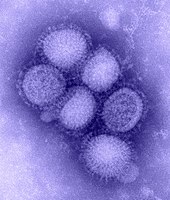
Photo from wikipedia
Background African swine fever virus (ASFV) is a most devastating pathogen affecting swine. In 2007, ASFV was introduced into Eastern Europe where it continuously circulates and recently reached Western Europe… Click to show full abstract
Background African swine fever virus (ASFV) is a most devastating pathogen affecting swine. In 2007, ASFV was introduced into Eastern Europe where it continuously circulates and recently reached Western Europe and Asia, leading to a socio-economic crisis of global proportion. In Africa, where ASFV was first described in 1921, it is transmitted between warthogs and soft ticks of the genus Ornithodoros in a so-called sylvatic cycle. However, analyses into this virus’ evolution are aggravated by the absence of any closely related viruses. Even ancient endogenous viral elements, viral sequences integrated into a host’s genome many thousand years ago that have proven extremely valuable to analyse virus evolution, remain to be identified. Therefore, the evolution of ASFV, the only known DNA virus transmitted by arthropods, remains a mystery. Results For the identification of ASFV-like sequences, we sequenced DNA from different recent Ornithodoros tick species, e.g. O. moubata and O. porcinus , O. moubata tick cells and also 100-year-old O. moubata and O. porcinus ticks using high-throughput sequencing. We used BLAST analyses for the identification of ASFV-like sequences and further analysed the data through phylogenetic reconstruction and molecular clock analyses. In addition, we performed tick infection experiments as well as additional small RNA sequencing of O. moubata and O. porcinus soft ticks. Conclusion Here, we show that soft ticks of the Ornithodoros moubata group, the natural arthropod vector of ASFV, harbour African swine fever virus-like integrated (ASFLI) elements corresponding to up to 10% (over 20 kb) of the ASFV genome. Through orthologous dating and molecular clock analyses, we provide data suggesting that integration could have occurred over 1.47 million years ago. Furthermore, we provide data showing ASFLI-element specific siRNA and piRNA in ticks and tick cells allowing for speculations on a possible role of ASFLI-elements in RNA interference-based protection against ASFV in ticks. We suggest that these elements, shaped through many years of co-evolution, could be part of an evolutionary virus-vector ‘arms race’, a finding that has not only high impact on our understanding of the co-evolution of viruses with their hosts but also provides a glimpse into the evolution of ASFV.
Journal Title: BMC Biology
Year Published: 2020
Link to full text (if available)
Share on Social Media: Sign Up to like & get
recommendations!